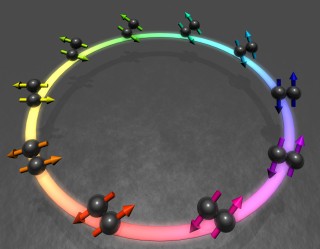Flocks of birds, sand dunes or traffic jam – in all of these everyday-life examples, so called collective behavior plays a crucial role: all participating objects move synchronously – no matter if voluntarily. A CUI-research team has now realized a novel quantum system of fermionic atoms showing collective behavior about which they report in Science magazine of 10 January 2014.
The CUI researchers of the group of Klaus Sengstock could for the first time observe a collectively swinging cloud of ultracold atoms as if they were dancing a quantum mechanics version of the Viennese Waltz.

The spin dance
Especially fascinating is the fact that the particles are fermions, known in physics for their behavior typically not to act collectively. In nature, there are two fundamental kinds of particles: bosons and fermions. They only differ in a single quantum mechanical quantity: their spin. “There is no classical analogue”, says Christoph Becker, scientific leader of the project. “At most, one could imagine the particles spinning around”. The spin leads to drastic differences in the ‘social behavior’ of the particles: bosons have integer spin, are ‘social’ and always try to act collectively. Fermions, however, have half-integer spin and are ‘loners’ so they tend to avoid each other as good as possible.
The constituents of matter, such as neutrons, protons and electrons are fermionic, so collective behavior in real quantum systems is only rarely found. But if it happens, it often leads to unexpected and completely novel effects which are also of great use for modern technology. A well-known example is the abovementioned superconductivity which leads to dissipation-free movement of pairs of electrons through a conductor.
The CUI research team has now succeeded in realizing a novel fermionic quantum system in their laboratory, which surprisingly acts collectively. Therefore, the researchers cooled down many atoms of the isotope 40K to nearly absolute zero temperature (minus 273° C) by using laser light. At these temperatures, the particles form a quantum state, called ‘Fermi sea’, named after Enrico Fermi, one of the pioneers of quantum mechanics. It has only been possible to realize these temperatures within the last few years.
“We had already observed that bosons behave collectively in spin rotation”, reports Klaus Sengstock, experimental leader of the team. “It was however a completely open question what would happen with fermions in that case.” After the cooling procedure, the researchers manipulated the fermions with laser light, thus orienting the spin of the particles. This allowed the researchers to observe how the spin of all of the fermions started oscillating in common mode – similar to a Viennese Waltz, when all couples on the dance floor spin around with the same velocity.
In cooperation with colleagues from Dresden and Barcelona the phenomenon could be analyzed experimentally and theoretically. “All atoms are linked to each other, that’s why this surprising effect occurred”, explains Maciej Lewenstein from Barcelona, who is leading the theory team. “For such complex systems no simple formula exists. We had to work out a novel effective theory to be able to describe the experiment correctly.” So the researchers found out that the collective behavior is a quantum phenomenon which is very sensitive to perturbations.
The results broaden the understanding of many-body systems and hence of fundamental aspects of nature. Possible future applications could be in quantum technology such as quantum sensors or quantum information technology.
Original Publication:
“Giant Spin Oscillations in an Ultracold Fermi Sea”
J. S. Krauser, U. Ebling, N. Fläschner, J. Heinze, K. Sengstock, M. Lewenstein, A. Eckardt, C. Becker
Science Vol. 343 no. 6167 pp. 157-160 (2014)
DOI: 10.1126/science.1244059

